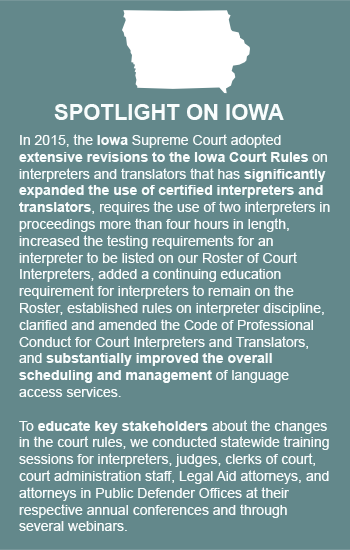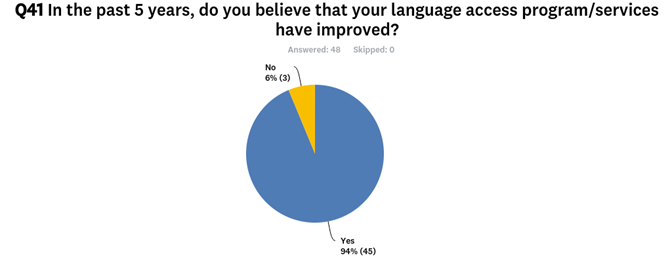In the survey, we asked 48 jurisdictions if they believed that their language access program/services have improved over the last 5 years. Overwhelmingly, 93% of jurisdictions answered that their programs or services indeed improved. This question sought to measure jurisdictions’ overall programmatic improvements.
The survey then asked the jurisdictions to support their answers and explain why they felt there were improvements. (Note: The survey did not ask respondents to support their answers with actual data.) Jurisdictions detailed improvements in the areas of: increased awareness, training, understanding of policies and mandates, revisions of court rules, credentialing and certifying interpreters, establishment of LAPs and oversight bodies, video remote interpreting, etc. Some states reported specific improvements and other states reported wide-ranging changes throughout their programs.
In addition, the survey revealed that a surprising number of jurisdictions referred to “increased awareness and understanding” as either the improvement made or the impetus for the improvement. There was a common theme that an increased awareness for the need for language access led to significant improvements, including compliance and understanding of policy and services. One state reported that their, "[s]tatewide language access awareness has been significantly heightened through ongoing training and outreach, and efficiency and effectiveness of interpreting services delivery has increased through remote interpreting expansion."
Jurisdictions also have utilized education as leverage to gain the support of leadership in increasing funding and policy changes. Further, more training has led to a widespread understanding of mandates, services available, and proper delivery of those services. Listed below are actual responses in the survey detailing the improvements throughout their programs.
Increased Awareness
- We have a heightened awareness/priority of the need for language access and our responsibility to provide language access for our customers.
- More people are aware of the requirement and need for language access.
- Much more comprehensive understanding of federal and state mandates.
- We believe that in the last 5 years our language access programs/services have improved. We obtained an additional $2 million dollars in the AOC budget for interpreter services for the courts which allows for the court system to be able to pay for interpreter services during all court hearings and allows for court appointed counsel to communicate with their clients during case preparation. We have educated all stakeholders in the legal system regarding the need to provide qualified interpreters and therefore awareness of the issues and needs has increased along with usage of interpreter services.
- Better services, more standardization, awareness.
- Increased awareness and understanding of policy and services.
- Training & awareness presentations for court staff and judiciary (new judges & a judicial training session)
- We have better compliance with use of certified interpreters; because of the extensive training we have done, our judiciary is better informed and sensitized to the need for qualified interpreters; we have implemented a CE requirement for on-going professional development of certified interpreters; and we have more certified interpreters in LOTS.
- By improving data collection and reporting we have been able to convince leadership of the depth of the program and the importance of addressing language needs.
- Michigan prior to this had no formalized system of language access provision. Today we have guidelines, registered interpreters, court rules, an oversight board for the profession and a better awareness by the Bench of the need.
- The implementation of local court LAPs, accompanied by increased training, raised awareness of language access. Our increased efforts on language access in general have resulted in improved compliance with our state law and regulations, in that local courts understand the need to provide qualified interpreters.
- Staff awareness and commitment ensures that the Branch complies with requirements
 Interpreter Credentialing and Certification
Interpreter Credentialing and Certification
- The number of certified/registered interpreters continually grows. Language access staff has received a growing number of requests to speak to various audiences thereby providing education of state and federal laws.
- People are beginning to understand that interpreters need to work in teams, that courts must pay for civil case interpretation and practicing attorneys, non-court staff and the Bar members are learning more about the statutory obligation to first seek NCSC-certified interpreters.
- Implementation of statewide credentialing program and availability of qualified interpreters to all courts.
- Doubled oral examination administrations and Orientation Workshop/Written Examinations. Now offered twice a year.
- With the development and implementation of the court interpreter training and certification program, the list of qualified court interpreters available to courts, attorneys, and others continues to expand both in the number of interpreters in the most needed languages, and in the number of languages represented.
- Our number and quality of interpreters has increased, and courts and probation services understand and appreciate the need for interpreters and generally make timely requests for language access services.
- MS has provided NCSC oral examinations for interpreters and have increased the number of registered and certified interpreters.
Training
- Statewide training for judges and staff. We adopting a Language Services Plan.
- We have provided training to chancery, circuit, county, municipal, justice, tribal and youth court judges.
Expanded Services
- Progress in the expansion of court interpreters in civil proceedings.
- Expanded to include interpreters at no cost to the party for juvenile, family, and guardianship cases; expanded to provide interpreters in civil cases with reimbursement required only on a case-by-case basis; and expanded to cover witnesses and participants other than just the person named in the complaint; Provided judge and staff training to make certain everyone working in the court system is aware of the rights and responsibilities imposed by law and court rule.
Comprehensive Program Improvements: Court rules, VRI, Translation of documents
- There has been continued development and refinement of LAP templates, implementation of an interpreter code of conduct and credentialing program, creation of the Court Interpreter Program Advisory Committee, and expansion of the video remote interpreting program.
- More information is available in different languages.
- We can see the tools for language access being used statewide. Language Access Services receives more court feedback and courts come to us to resolve issues and get resources. Increased data collections also supports evidence of improved services.
- The Texas Court Remote Interpreter Service was established in September 2014.
- We have an active G.L. Chapter 221C committee, currently working on finalizing revisions to the Standards and Procedures for the Office of Court Interpreter Services (OCIS). We have translated many court documents in most requested languages (ex., Spanish, Portuguese, Haitian, Khmer, and Vietnamese).
 Video remote technology has enabled us to provide certified interpreters from other state courts. The court system now has a qualified Yup'ik interpreter on-staff. With the hiring of a full-time interpreter services coordinator, the court system is able to provide interpreting services in a timely manner and is able to monitor interpreting services. The revision of Administrative Rule 6 enables the court to provide qualified interpreters for all courtroom hearings. The revision has greatly improved the cost and quality of interpreting services.
Video remote technology has enabled us to provide certified interpreters from other state courts. The court system now has a qualified Yup'ik interpreter on-staff. With the hiring of a full-time interpreter services coordinator, the court system is able to provide interpreting services in a timely manner and is able to monitor interpreting services. The revision of Administrative Rule 6 enables the court to provide qualified interpreters for all courtroom hearings. The revision has greatly improved the cost and quality of interpreting services. - Improved quality of interpreting services in in-court proceedings (criminal and civil cases) by increasing the number of certified and qualified interpreters. About 95% of proceedings are covered by fully certified interpreters. Improved access outside the courtroom by training and certifying over 100 bilingual employees in Spanish, Navajo, Mandarin, Polish and Keres and equipping the courts with I-speak cards, on-demand telephonic interpreting services and multi-lingual signage. Improved access to written materials by translating our judiciary's website and DV and DR forms. Improved access to justice for Native Peoples by developing a training and certification program for Navajo and Pueblo languages and training judges on cultural competency. Increased awareness about Title VI, ADA and language access policies by holding regular LAP meetings and training, launching a language access website and portal for judges.








